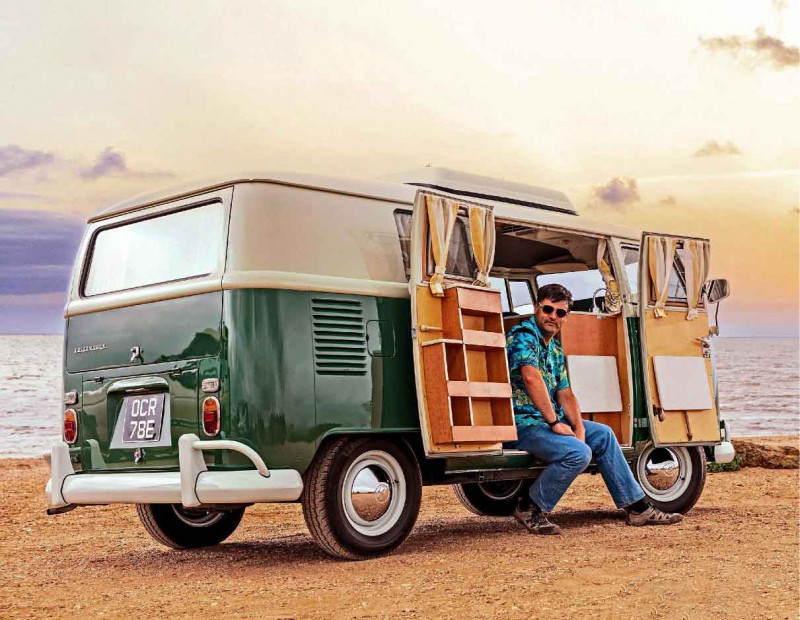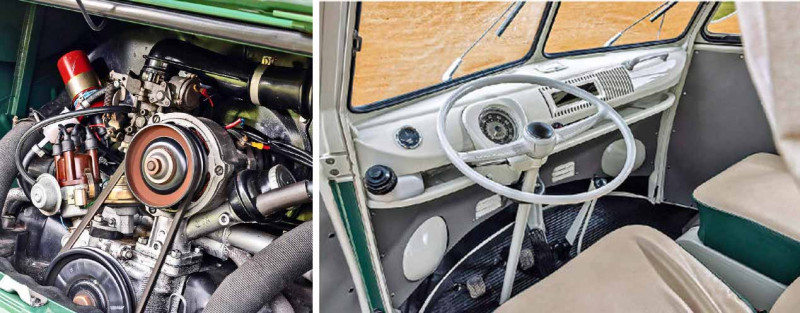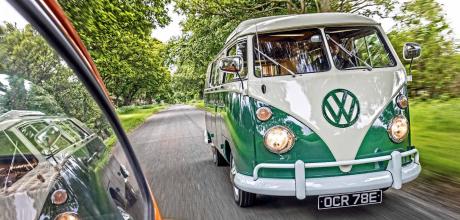1967 Volkswagen Type 2 Camper
Clambering aboard this split-window Type 2 Camper – and you really do have to climb up into it, it’s surprisingly high off the ground – the thing that surprises me most is how far removed from the Beetle it is. I know it’s built on that car’s floorplan and shares its engine and gearbox. But it’s testament to the ingenuity of VW’s platform engineering that the thing it reminds me most of is not a car, but the 201 bus to Stamford.
In the context of the commercial vehicle world it was launched it into as a versatile van, the T2 was near-unique in its mechanical layout, and it feels special even in a world where MPVs have been with us for 40 years. Because it’s laid out just like a modern bus: driver’s cab ahead of the front wheels, engine slung out at the back and the interior as space-maximised as possible for your imagination to run riot. Mobile surf shack? Fitted kitchen? Beds? Artists’ studio? Bar? Unlike any other classic, the T2 is whatever you want it to be as well as a car.


I find myself mumbling ‘All aboard!’ to myself as I negotiate the coffee-table steering wheel. The way the front end swings out when cornering, the axle whining over the distant engine note, and the way you just accept a kind of 40mph-everywhere ponderousness while enjoying panoramic views are all more reminiscent of a bus journey than a car drive. Perhaps it’s this factor as much as any hippy or surfer connotations that make the T2 one of those classics that perennially appeals to buyers beyond the classic car world. Even people who don’t know what a carburettor is and glaze over in the company of car spods will often tell you that they’d quite fancy a VW Camper one day.
And they’ll be thankful that the driving experience is novice-friendly too. The steering is light, the gearbox is ponderous but soon acclimatised to with its long, easily-found ratios, and the brakes are as effective as a Beetle’s despite a 1297kg kerbweight. There is one main issue with the T2, although whether it’s a problem or not depends on your mindset. It’s sluggish. Yes, mechanically it kept pace with the Beetle until 1972, and got its own 1.7/2.0 aircooled flat-four engines for a decade beyond that. But with the extra weight to haul around, no T2 will get anywhere near 70mph. As a result you can forget Friday-night dashes to Cornwall unless you live in Devon. But immerse yourself in the T2 lifestyle and it’s a different story. The journey becomes part of the holiday itself, and home is where you park it. It may not cover ground in a grand way, but it’s a tourer like no other – and try getting a good night’s sleep in a Jaguar E-type.
One thing a split-screen T2 like this one does have in common with an E-type nowadays is the price premium. They’re often the subject of exacting, intensely personal and very high-quality restorations, and this is reflected in the £35k-£45k tag you’ll find on the best standard examples with Westfalia camper innards complete with sink, cooker, cupboards and fold-out beds. It’s also one of those cars that can realise the value of modifications made: Alfa Romeo flat-fours or Porsche 911 flat-sixes make them more usable, and there are firms that will trim them to Rolls-Royce standards or stuff them with high-tech outdoors and entertainment equipment. Such things make them as soughtafter as supercars, with six-figure values to match.
Thankfully, ‘bay-window’ Type 2s – merely reflecting the point where curved-glass technology meant the car’s aerodynamics didn’t need a glass prow at the front – can be had in decent running order from £6750 for a Seventies example.
As with the Beetle, it’s another case of sheer numbers and length of production – until 2013 in Brazil – meaning that parts supply isn’t an issue. But rust sadly is, and hard lives and complex internal configurations mean this isn’t as straightforward to deal with. Also, while bodywork and mechanical parts are easy to come by, the number of firms kitting them out means finding authentic interior parts can be difficult, especially if it was converted by a lesser-known or now-dormant coachbuilder. That said, the very appeal of these vehicles lies in their sense of DIY personalisation, and projects that are just as at-home on George Clarke’s Amazing Spaces as they are in the pages of this magazine.
Owning a Type 2 Camper
‘It started life as a minibus, but I found it on a farm in Wales with grass growing through the floor,’ says Bob Grimley of his 1979 Type 2. ‘I converted the interior to a Campervan, using Ikea units sold off in their clearance section, as well as restoring the body and mechanicals. It took me four years, on and off.
‘They’re usually easy to get parts for because Volkswagen continued building them for so long in Mexico and Brazil. However, any parts for the Type 4 2.0-litre engine tend to be twice the price of its 1600 counterpart – partly because it’s rarer but also because the larger engine was used by Porsche in the 914, and they carry Porsche prices.
‘I use it as intended – weekends away, staying in at shows – but I’ve made it more useable than even VW intended, adding a toilet and Propex central heating.’
TECHNICAL DATA 1967 Volkswagen Type 2 Camper
- Engine 1493cc horizontally-opposed four-cylinder, ohv, Solex 31 Pict 4 carburettor
- Max Power 53bhp @ 4200rpm
- Max Torque 78lb ft @ 2600rpm
- Transmission Four-speed manual, rear-wheel drive
- Steering Worm and roller
- Suspension Front: independent, torsion bars, trailing arms, telescopic dampers, anti-roll bar. Rear: independent, torsion bars, swing axles, telescopic dampers
- Brakes Drums all round
- Performance Top speed: 65mph
- Acceleration 0-60mph: n/a
- Weight 1297kg
- Fuel consumption 23mpg
- Cost new £1213 (1968, including Camper conversion)
- Classic Cars Price Guide £16,000-£64,000
Relative light weight, engine unstressed. More similar to a bus than a conventional car. ‘Splittie’ pricey, other VW vans are cheaper.
There are two very distinct species of VW on offer here, and with them two completely different cults of ownership beckoning that seem strangely at odds with each other. The watercooled era, covered in distinct Audi fingerprints, is still with us today, no matter how VW’s marketing likes to hide behind carefree hippy imagery and tempt us with a colourful new Microbus. There’s a strict rationality to the VW that’s existed since the emergence of the Golf, one that found a new role as the upwardly mobile’s vehicle of choice. One for whom words like ‘premium’ managed to be associated with the ‘people’s car’, which now positions itself above Skoda and Seat despite selling ostensibly the same product. The Golf GTI is the true icon of that new Volkswagen, but in truth it marked the point where VW became a lot like other car companies. To this end, the Corrado embodies the perfection of this new ideal – a Karmann-Ghia with genuine sporting substance to give Porsche a proper kicking this time. As the front-drive coupés of the Nineties finally get the recognition they deserve, the Corrado VR6 will hopefully be seen as the finest of the breed, and technically fascinating to boot. In a way it’s a shame there was no way for the Corrado to prove itself in racing or rallying, because I suspect otherwise it would bask in a reputation comparable to that of the Lancia Delta Integrale. Then again, maybe it’s still a bargain because it doesn’t? But there are other cars like the VR6 from the likes of Vauxhall and Alfa Romeo. Whereas the cult of VW lies surely in the unique heritage of a company that rejected the automotive establishment thinking that had resulted in built-in obsolescence and status-seeking, and in doing so attracted the leading proponents of counter-culture itself. And nothing sums this up quite so well as the Type 2. It’s built to the same principles as the Beetle, but it’s far more than just a car. Owning one is like buying a canal boat or a horse – it commits you to a different, more fulfilling way of life. Granted, it isn’t fun to drive in a sporty sense. But if you own one and use it as intended, you will make friends that you wouldn’t have if you hadn’t. It will enable new adventures. It will unlock entry to new events. You can express yourself in the way you configure, design and decorate it in a way you just can’t with other cars. And you can get into one for less than you might think. This ‘splittie’ may be the icon, the one that started it all, but the culture it represents can be accessed via a beaten-up old T3. Long may that last.
‘Owning one is like buying a canal boat or a horse – it commits you to a more fulfilling way of life’
The Camper: another way of life as well as an iconic classic car


